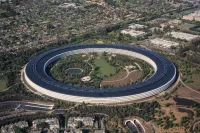Cupertino, California, is a city in Santa Clara County with a population of approximately 60,000 as of 2020. Situated west of San Jose, it's located on the edge of the Santa Clara Valley and extends into the Santa Cruz Mountains foothills. Cupertino is most notably the global headquarters of Apple Inc., which operates from its large campus, Apple Park, located within the city.
1939: Kaiser Permanente Cement Plant Founded
In 1939, the Kaiser Permanente Cement Plant was founded by Henry J. Kaiser, later known as Lehigh Southwest Cement. It provided cement for the construction of the Shasta Dam.
1954: Drive for Incorporation Begins
In 1954, a drive for the incorporation of Cupertino began.
September 27, 1955: Voters Approve Cupertino Incorporation
On September 27, 1955, voters approved the incorporation of the city of Cupertino.
October 10, 1955: Cupertino Becomes Santa Clara County's 13th City
On October 10, 1955, Cupertino officially became Santa Clara County's 13th city.
1955: Cupertino Incorporated in 1955
Cupertino was incorporated in 1955. The City Council consists of five members serving four-year terms.
1955: Cupertino Officially Incorporated
In 1955, Cupertino was officially incorporated, marking a significant milestone in its development.
1960: Contemporary Properties Developed Around 1960
Most of Cupertino's contemporary properties were developed around 1960.
1967: De Anza College Opens
In 1967, De Anza College opened its doors, named after Juan Bautista De Anza.
1999: Rancho Rinconada Annexed in 1999
Rancho Rinconada was annexed into Cupertino in 1999.
2002: Cupertino's Unemployment Rate
In 2002, Cupertino had a labor force of 25,780 with an unemployment rate of 4.5%.
2004: Cupertino Library Redesigned and Rebuilt
In 2004, the Cupertino Library, operated by Santa Clara County Library, was redesigned and rebuilt.
2004: Last Part of Monta Vista Annexed in 2004
The last part of Monta Vista was annexed into Cupertino in 2004.
2006: Apple Buys Properties South of Pruneridge Avenue
In 2006, Apple Inc. bought nine properties (50-acre) south of Pruneridge Avenue in Cupertino for its new headquarters.
April 30, 2009: Mary Avenue Bicycle Footbridge Opens
On April 30, 2009, Cupertino opened the Mary Avenue Bicycle Footbridge, a cable-stayed bicycle-pedestrian bridge over a California freeway.
2010: Asian Ancestry Population in Cupertino
In 2010, 63 percent of Cupertino's population was of Asian ancestry, compared to 32 percent in Santa Clara County overall.
2010: Apple Buys Property North of Pruneridge Avenue from HP
In 2010, Apple bought a 100-acre property north of Pruneridge Avenue from Hewlett-Packard (HP) in Cupertino for its new headquarters.
2010: HP Consolidates and Closes Cupertino Campus
In 2010, HP consolidated its Bay Area workforce in Palo Alto, leading to the closure of its Cupertino campus. It was estimated that 3,000 to 3,500 employees would be relocated. Apple later bought the campus site.
June 7, 2011: Steve Jobs Presents Apple's New Campus Design
On June 7, 2011, Steve Jobs presented the architectural design of Apple's new campus to the Cupertino City Council.
2012: Cupertino Ranked #27 in Money's Best Places to Live
In 2012, Money's Best Places to Live, ranked Cupertino as #27 in "America's best small towns", the second highest in California.
2014: Cupertino Ranked Seventh Happiest Suburb
In 2014, Movoto Real Estate ranked Cupertino the seventh "happiest" suburb in the United States, based on income, safety, marriage, and education.
2015: Cupertino Ranked as One of the Most Educated Places in the U.S.
In 2015, Forbes ranked Cupertino as one of the most educated places in the U.S. in respect to the percentage of high school and college graduates.
October 2019: Cupertino Launches On-Demand Public Transportation Network
In October 2019, the City of Cupertino partnered with Via Transportation to launch Via, a new on-demand public transportation network.
2020: Cupertino Population
As of the 2020 census, the population of Cupertino was 60,381.
2020: Cupertino Population Reported in 2020 Census
The 2020 United States census reported that Cupertino had a population of 60,381.
2022: Top Employers in Cupertino
According to the city's 2022–23 Comprehensive Annual Financial Report, the top employers in the city are listed.
2022: De Anza College Enrollment
As of 2022, De Anza College had 16,335 students.
2022: High Housing Prices in Cupertino Peak
As of the priciest housing market peak of 2022, Cupertino is known for its high housing prices, with entry-level single-family homes starting around $2 million in the Cupertino HS area and $2.6 million in the Monta Vista HS area. Larger homes can go up to $7 million.
2023: Foreign-Born Population Estimate
In 2023, the US Census Bureau estimated that 55.1% of Cupertino's population were foreign-born.
2023: Median Household Income
The median household income in Cupertino in 2023 was $231,139, and the per capita income was $106,821. About 3.2% of families and 4.3% of the population were below the poverty line.
Mentioned in this timeline

Apple Inc founded in and headquartered in Cupertino California is...
The United States of America is a federal republic located...
California is a U S state on the Pacific Coast...

An apple is a widely cultivated edible fruit originating in...

September is the ninth month of the year in the...

Money serves as a universally accepted medium for exchanging goods...
Trending
47 minutes ago Discord Checkpoint 2025: A Spotify Wrapped-like Recap for Gaming Habits in League of Legends.
48 minutes ago Mortgage Rates Fall: Refinance Opportunities and Lender Options Emerge in December 2025

2 hours ago Dave Chappelle Heckled in Edmonton: Show Interrupted, Future Performances in Doubt.

2 hours ago Below Deck's Fraser Olender Suffered Heart Attack Due to Vaping at the Age of 33
3 hours ago OnlyFans Model Bonnie Blue Detained in Bali for 'Bangbus' Tour Stunt.

3 hours ago Jackson Wang Announces 2026 'Magicman 2' North American Tour: Dates and Details
Popular
Matt and Ross Duffer known as the Duffer Brothers are...
Aftyn Alyssa Behn is an American politician currently serving as...

XXXTentacion born Jahseh Dwayne Ricardo Onfroy was a controversial yet...

Lane Kiffin is an American football coach currently serving as...

Candace Owens is an American conservative political commentator and author...

Stranger Things created by the Duffer Brothers is a popular...
